
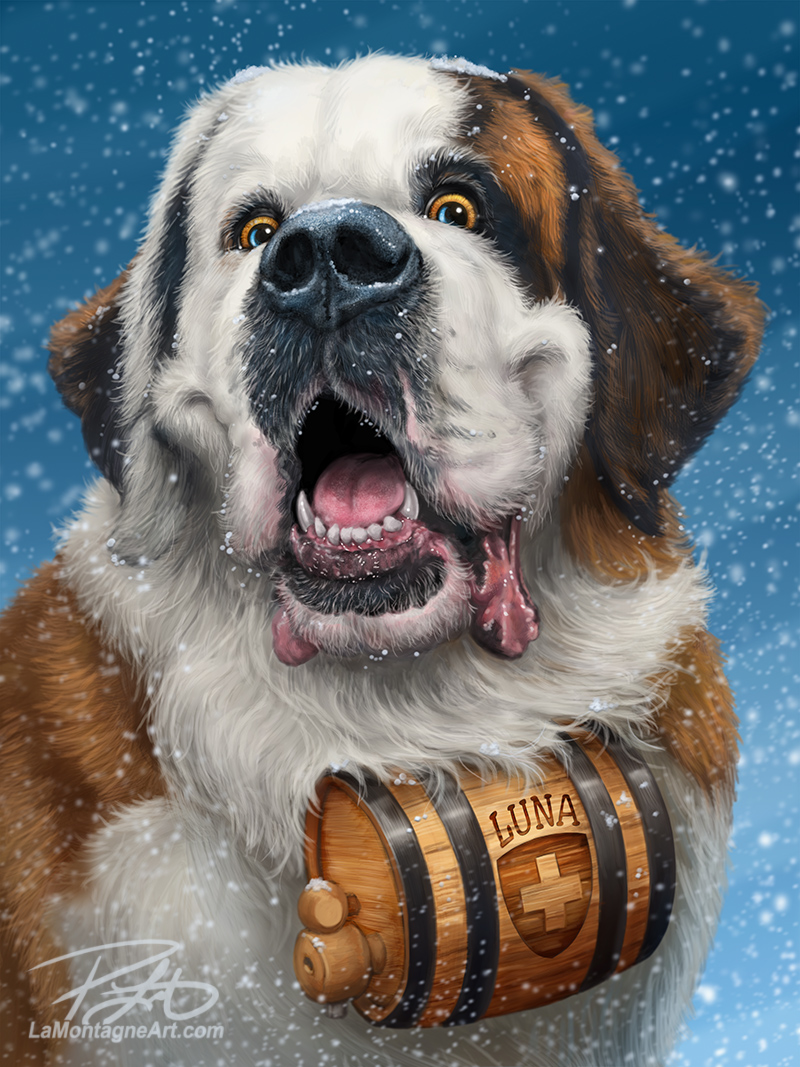 While commissions are a small part of my overall work and business, I’ve enjoyed the pet portraits I’ve painted over the years. All have been challenging, either the artwork or managing client expectations. Though I have my personal favourites, I’ve learned something valuable from each.
While commissions are a small part of my overall work and business, I’ve enjoyed the pet portraits I’ve painted over the years. All have been challenging, either the artwork or managing client expectations. Though I have my personal favourites, I’ve learned something valuable from each.
A couple of years ago, my friend and marketing guru David Duchemin suggested my rates were too low. Artists are notorious for undervaluing their skills, often attracting the wrong clients, those more interested in a bargain than the artwork.
A commission is a custom portrait requiring consultation, preparation, printing, and shipping/delivery, plus many hours of actual painting. Unlike my whimsical wildlife portraits, which can be sold as prints and licensed, a commission is an original work created for one client.
David asked me to consider whether I would rather have more clients at a lower rate or fewer clients at a rate more appropriate to the years I’ve put into my skills and the unique look of my critters.
I took that to heart and raised my rate because when I’m painting a commissioned piece, that’s time that can’t be spent painting anything else.
On my site, I’m upfront about pricing, the photos I need for reference, and the details a client needs to make an informed decision without making it awkward if the price is out of their range. I’m happy to answer inquiries, but with my daily editorial cartoons and new whimsical wildlife pieces, the commission work is welcome when it comes in, but I don’t actively market it.
My first and last paintings of 2022 were pet portraits, both thoroughly enjoyable experiences with great clients, nice bookends for the year.
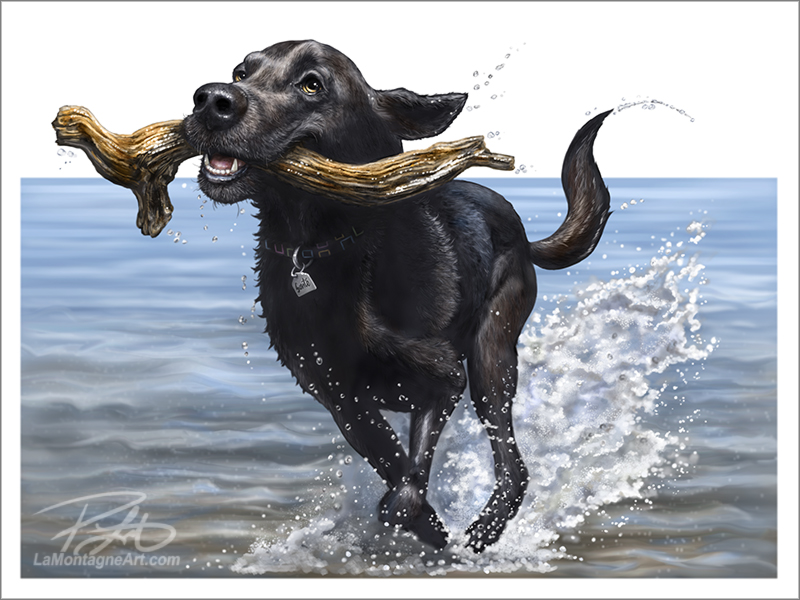 Santé was a memorial piece. Suzanne wanted my whimsical style and a full-body action pose, something I hadn’t yet painted in a commission. She wanted the painting to portray the active and joyful full life that Santé led and had the photo reference to back it up. While difficult, it stretched my skills, and I was pleased with the result. Click here to read more about that experience in the original post.
Santé was a memorial piece. Suzanne wanted my whimsical style and a full-body action pose, something I hadn’t yet painted in a commission. She wanted the painting to portray the active and joyful full life that Santé led and had the photo reference to back it up. While difficult, it stretched my skills, and I was pleased with the result. Click here to read more about that experience in the original post.
Near the end of October, I got an email from a man in Calgary asking me to paint his dog Luna, a gift for his wife. He’d read the Commissions page, knew what he wanted, and even included some initial reference photos. Talk about a good start.
We’d briefly discussed a possible commission at the Calgary Expo in April, but while I get several inquiries at that event, this is the first one that has resulted in a hire.
Given the time of year, I assumed this was a Christmas present. However, when I asked, he replied, “not a huge rush, if we got it for Christmas it would be a great surprise, but I’m not overly concerned if we don’t get it until the new year.”
I thought that if we could reach an agreement quickly, I would make that surprise happen.
I asked if he could take more photos for me, offering a little guidance on what would be ideal. He got right to it and I ended up with great bunch of reference. In one of them, I noticed she had a little brandy keg around her neck, and I asked him if I could paint her in a winter scene with that keg. Sure, it’s a cliché image of a St. Bernard, but it was too perfect a fit, and I could see the painting in my head. Jeremy liked the idea and said that Luna loves the snow.
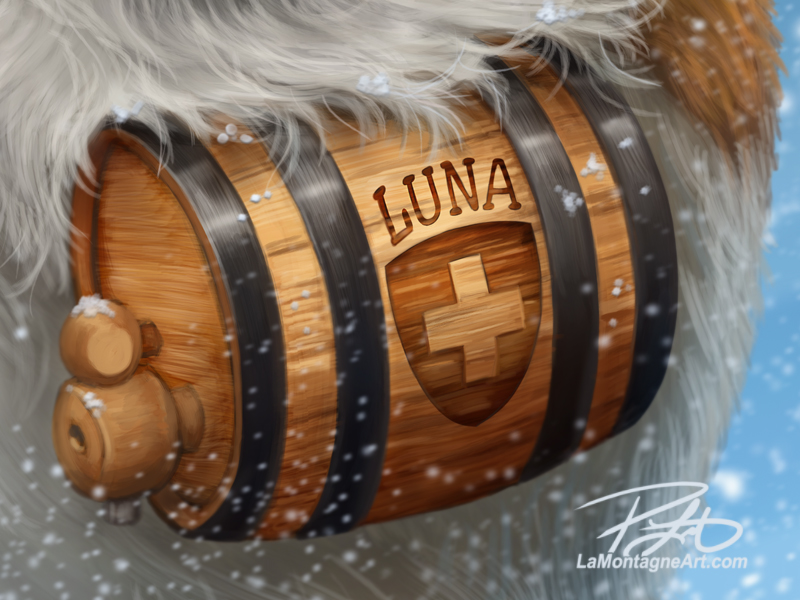 At the beginning of December, I sent him the finished piece for approval before it went to the printer. Of the options I offer, he had initially chosen an 18X24 canvas, and while that would have looked great, I talked him into going with the same size matte metal piece instead. With the bright, vibrant colours in this painting, I knew it would pop a lot more on metal.
At the beginning of December, I sent him the finished piece for approval before it went to the printer. Of the options I offer, he had initially chosen an 18X24 canvas, and while that would have looked great, I talked him into going with the same size matte metal piece instead. With the bright, vibrant colours in this painting, I knew it would pop a lot more on metal.
I’ve been having my metal and canvas prints done by Posterjack for over a year now. Everything is always well-packed, and this was no exception. The colours and quality of the Luna print were stunning.
But you can imagine my disappointment when I noticed some slight damage in the bottom right corner. There was no damage to the box and it was wrapped well inside. In their busy season, somebody likely knocked it during production and failed to notice before packing it. It was a tiny dent, only noticeable on close inspection.
I put some foam wrapping around the corner and gently bent it back into place with some pliers. Then I took a white paint pen, blended it with a little blue and smudged over the corner with a Q-Tip, blending it as best I could into the sky and snow background. It was the only corner of the painting where this could have worked. I did a pretty good job of it, too, but I could still see the damage.
While setting up and working at markets, no matter how careful I’ve been, I’ve dinged a couple of these myself in the same way. I might bump one, and it falls off the gridwall, that sort of thing. In those cases, I’ll offer a discount to anyone interested in that piece, which is usually acceptable. It’s almost always barely noticeable and this was the same type of subtle damage.
But this was a custom commission.
I told the client about it; said I’d still drive it in the next day and see what he thought. He wasn’t too concerned, but I wasn’t comfortable with his settling for a damaged print. But at least he’d have the piece to give to his wife for Christmas, and I could replace it afterward.
I sent Posterjack a photo of the damage, and they immediately offered a replacement. However, since I wasn’t sure it would arrive before Christmas, I delivered the print I had.
Of course, while preparing to deliver the piece, I had to ask, “do I get to meet Luna?”
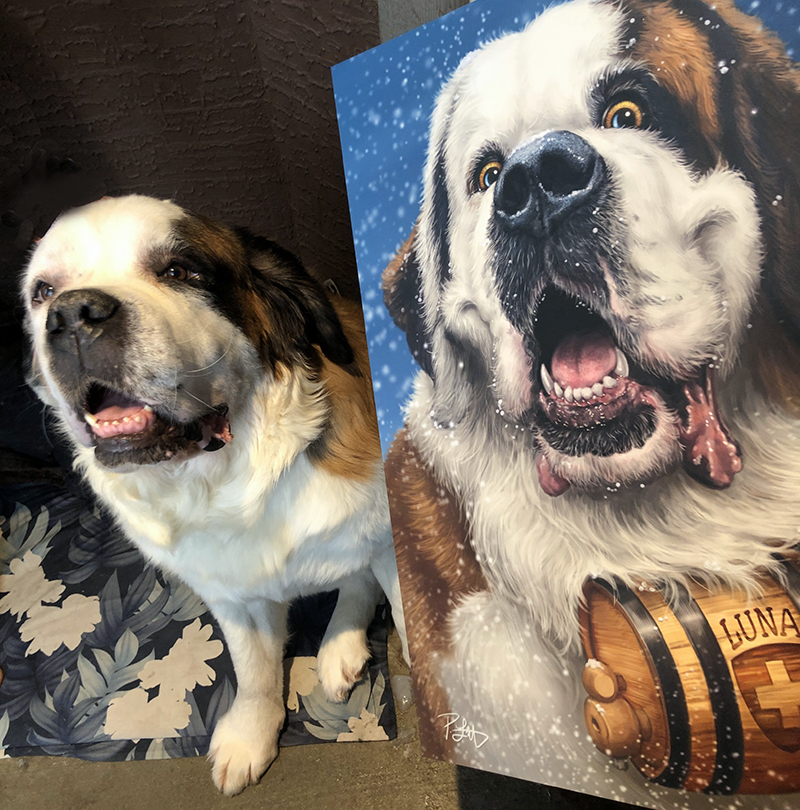 She’s exactly as you’d expect, a big slobbery friendly St. Bernard with the sweetest face and lovable eyes. I would have liked to have taken a better photo with her, but Jeremy and I met in their enclosed front porch, with Luna and her Newfoundland sister, Sally, between us. As they’re both BIG dogs, it was a little cramped, but Jen was home, so there was a risk of ruining the surprise.
She’s exactly as you’d expect, a big slobbery friendly St. Bernard with the sweetest face and lovable eyes. I would have liked to have taken a better photo with her, but Jeremy and I met in their enclosed front porch, with Luna and her Newfoundland sister, Sally, between us. As they’re both BIG dogs, it was a little cramped, but Jen was home, so there was a risk of ruining the surprise.
The replacement print arrived five days later. I inspected it and wrapped it back up right away to keep it safe. I sent my Posterjack contact an email thanking them for standing by their product. Nothing secures my loyalty more than great service. Too many companies have forgotten that.
In ideal conditions, I could have gone to Calgary again to replace it before Christmas, but our weather turned incredibly nasty, temperatures between -30 and -40C every day all week, right after the starter in my car began to grind intermittently. Not the safest set of circumstances for a trip into the city.
With the starter replaced last week and this cold snap departed, I’ll soon arrange to make the exchange. I plan to display the original print at Expo in April, a full-size example to point to for any commission inquiries. In the meantime, I’ll hang it in my office because I do love it; such a fun piece to paint.
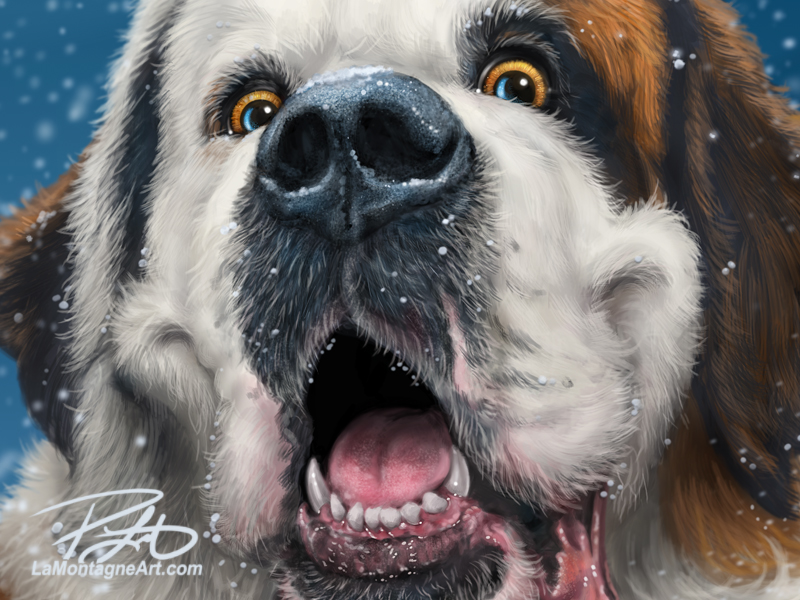 As for Jenny’s reaction, Jeremy sent me some pictures Christmas morning. Let me tell you, tears are the best compliment I ever get.
As for Jenny’s reaction, Jeremy sent me some pictures Christmas morning. Let me tell you, tears are the best compliment I ever get.

Click here for more information about pet portrait commissions. If you have any questions, drop me a line at patrick@nulllamontagneart.com



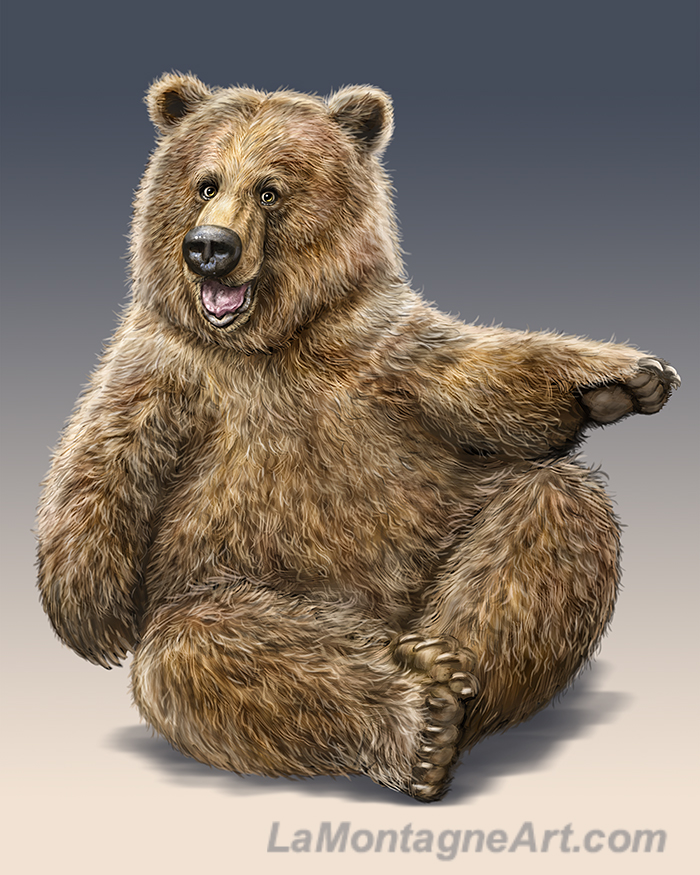


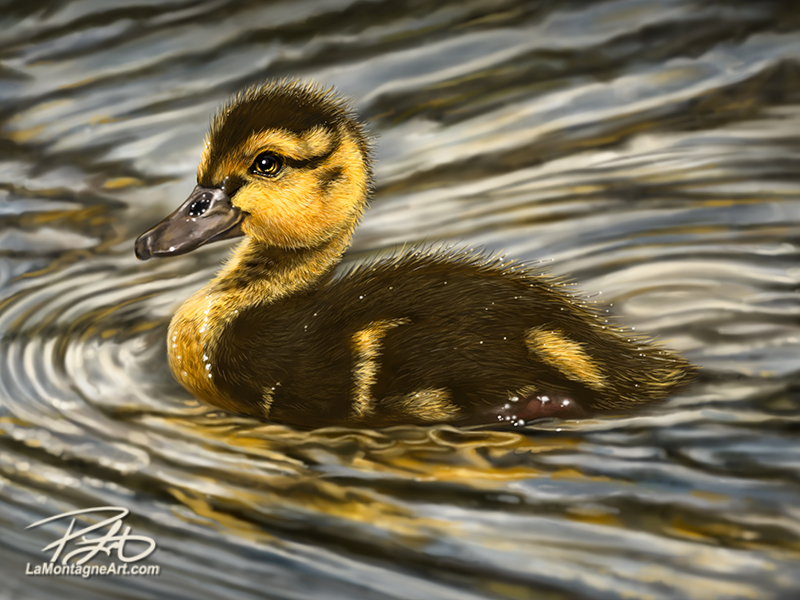 Here’s a little duckling I finished painting this morning. The duckling itself wasn’t difficult, but the water certainly was. Ironic that I began this year with a commission piece where water was also the hardest part of that painting. There will always be room for improvement in any artistic pursuit, so I welcome these unexpected challenges. The work might become boring without them.
Here’s a little duckling I finished painting this morning. The duckling itself wasn’t difficult, but the water certainly was. Ironic that I began this year with a commission piece where water was also the hardest part of that painting. There will always be room for improvement in any artistic pursuit, so I welcome these unexpected challenges. The work might become boring without them.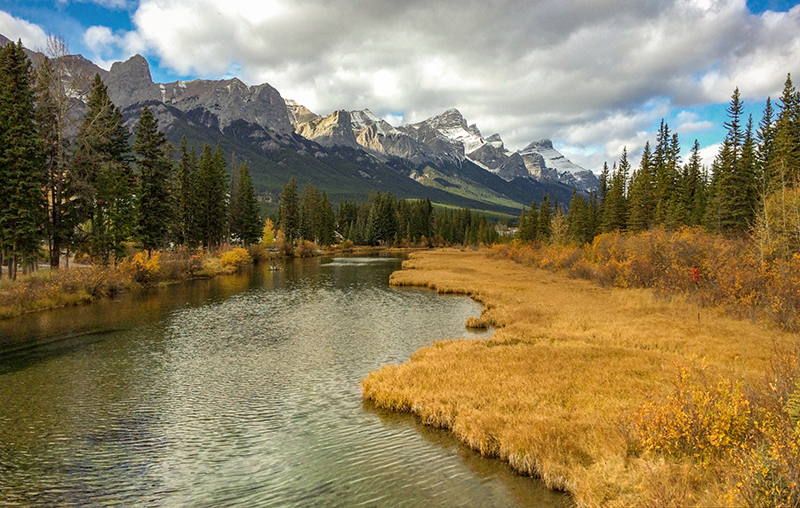 I took the reference for this painting four years ago from the boardwalk that winds through the Policeman’s Creek wetlands here in Canmore. Easily accessible for people of all fitness levels, it’s located in the middle of town and might as well be an urban park. It’s a pretty walk, a nice shortcut from where we live to downtown Canmore, and preferable to walking on the sidewalk of a busy street.
I took the reference for this painting four years ago from the boardwalk that winds through the Policeman’s Creek wetlands here in Canmore. Easily accessible for people of all fitness levels, it’s located in the middle of town and might as well be an urban park. It’s a pretty walk, a nice shortcut from where we live to downtown Canmore, and preferable to walking on the sidewalk of a busy street.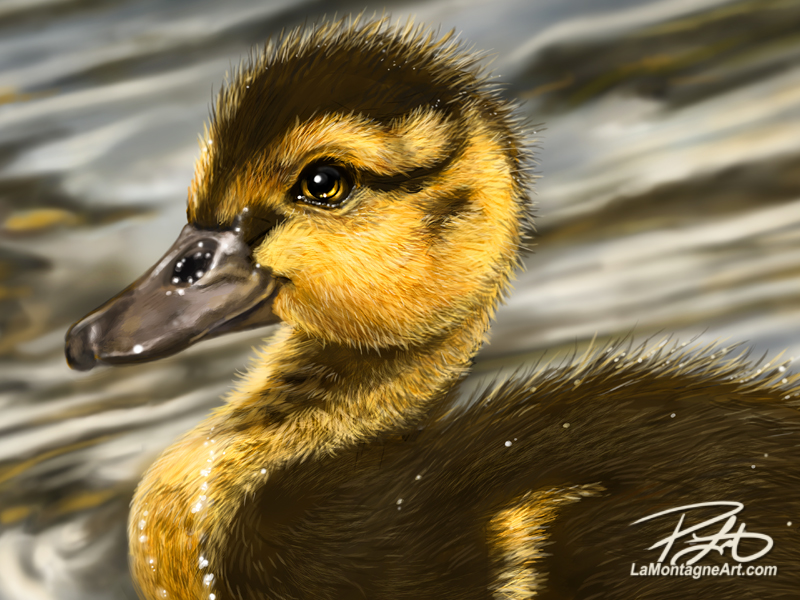 The reason for fewer paintings is no mystery. Despite the dramatic decline in the newspaper industry, it’s still a big chunk of my income, and I’m unable to put off or set aside my daily editorial cartoon deadlines. As a result, those take priority every day and painting time is often sacrificed for the cartoons.
The reason for fewer paintings is no mystery. Despite the dramatic decline in the newspaper industry, it’s still a big chunk of my income, and I’m unable to put off or set aside my daily editorial cartoon deadlines. As a result, those take priority every day and painting time is often sacrificed for the cartoons.
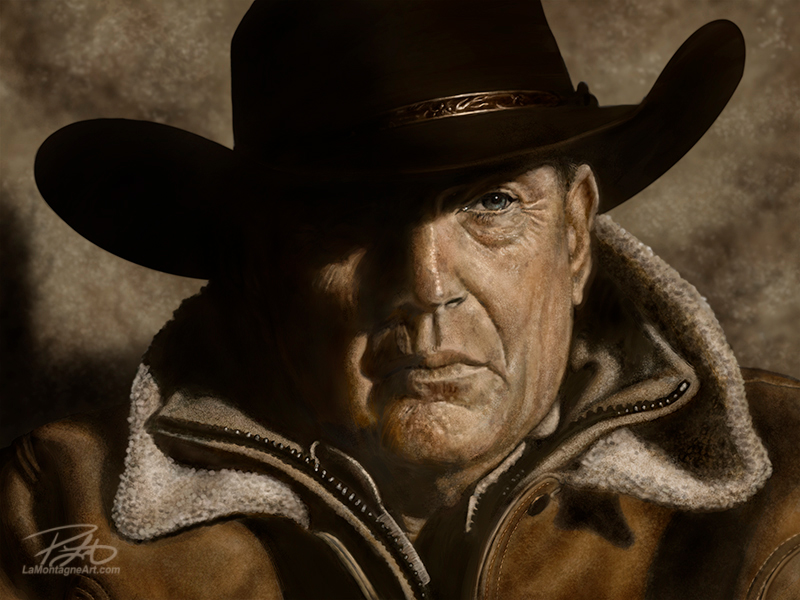
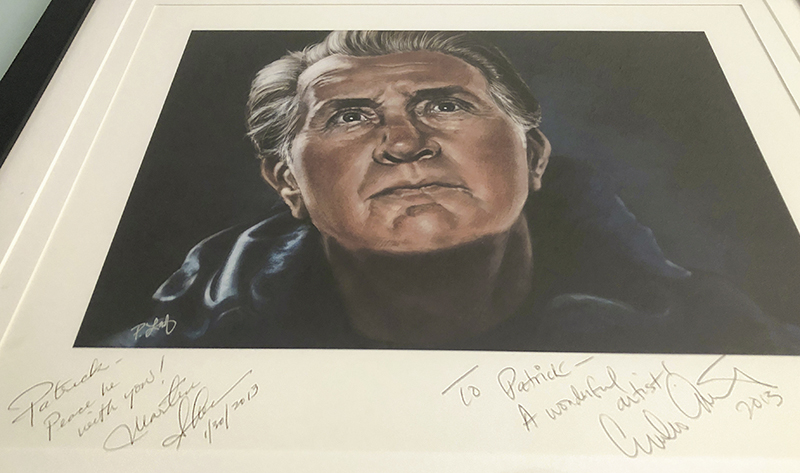 Another was when I painted Canadian astronaut Chris Hadfield while he was in command of the International Space Station. He saw
Another was when I painted Canadian astronaut Chris Hadfield while he was in command of the International Space Station. He saw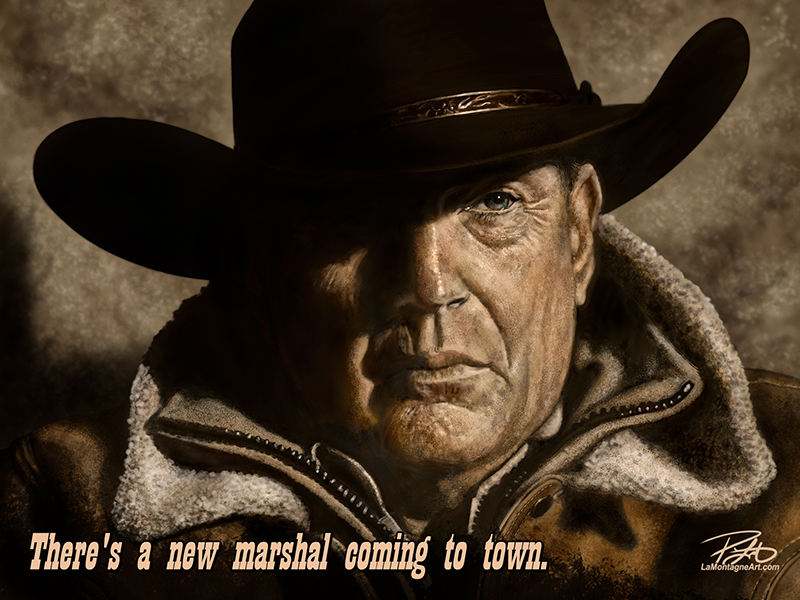 As it also made national news, and Yellowstone is a wildly popular show, I sent it out to my other papers this morning, in case there’s more interest in it. For context outside of Calgary, I added “Calgary Stampede:” before the caption for those other papers.
As it also made national news, and Yellowstone is a wildly popular show, I sent it out to my other papers this morning, in case there’s more interest in it. For context outside of Calgary, I added “Calgary Stampede:” before the caption for those other papers.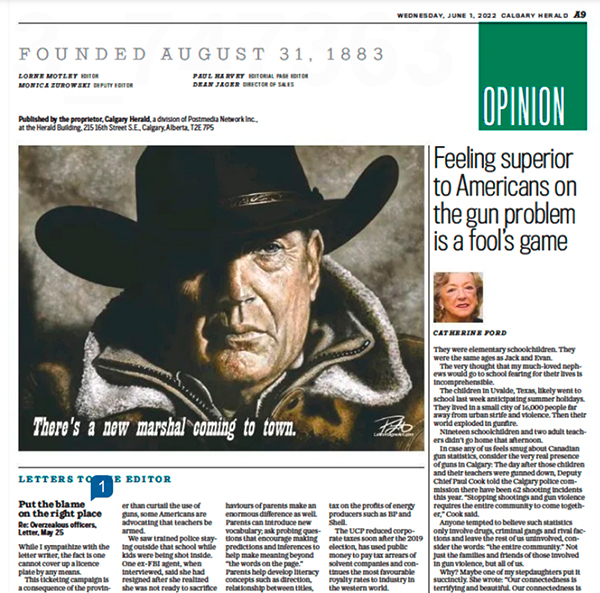 The Costner portrait file is 30” X 40” with a lot of detailed brushwork. To shrink it down and prepare it for newsprint, I had to boost the contrast, oversharpen it, and make other Photoshop adjustments to mitigate a poor result. So while I was happy to see it printed in the Calgary Herald (digital edition above), I couldn’t help but see all the flaws in the reproduction, even though I know that most people won’t notice or care.
The Costner portrait file is 30” X 40” with a lot of detailed brushwork. To shrink it down and prepare it for newsprint, I had to boost the contrast, oversharpen it, and make other Photoshop adjustments to mitigate a poor result. So while I was happy to see it printed in the Calgary Herald (digital edition above), I couldn’t help but see all the flaws in the reproduction, even though I know that most people won’t notice or care.
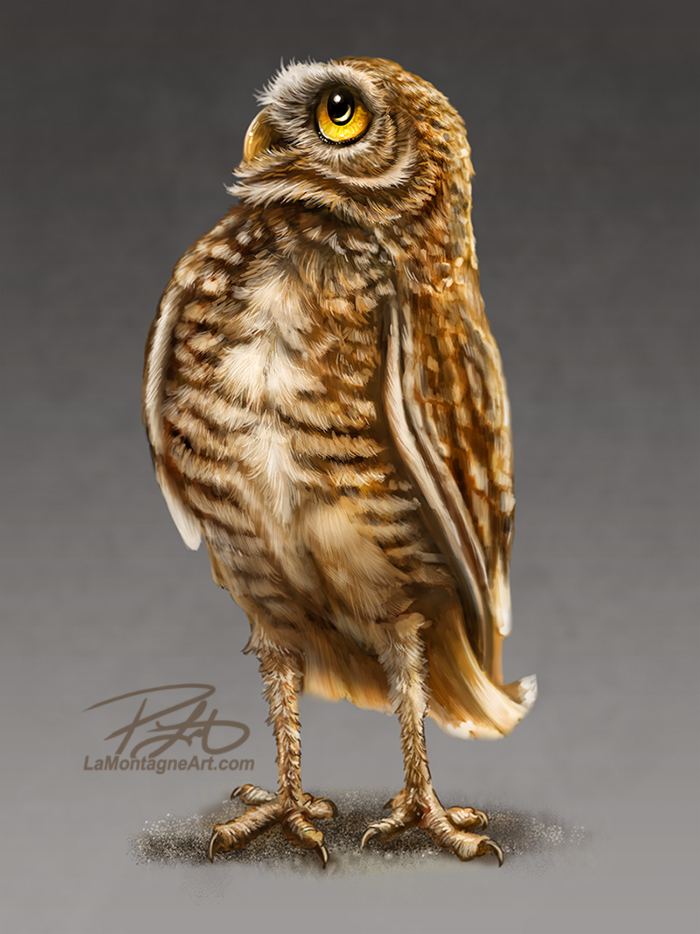 Here’s the fourth burrowing owl in the series, which will be part of a larger piece featuring multiple owls in different poses. I don’t know how many owls yet, and I only have a rough vision of it.
Here’s the fourth burrowing owl in the series, which will be part of a larger piece featuring multiple owls in different poses. I don’t know how many owls yet, and I only have a rough vision of it.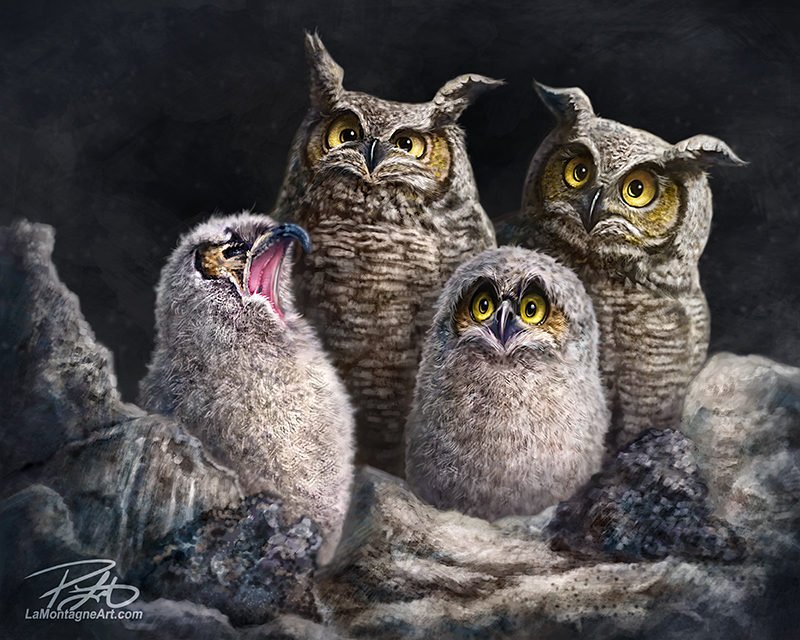


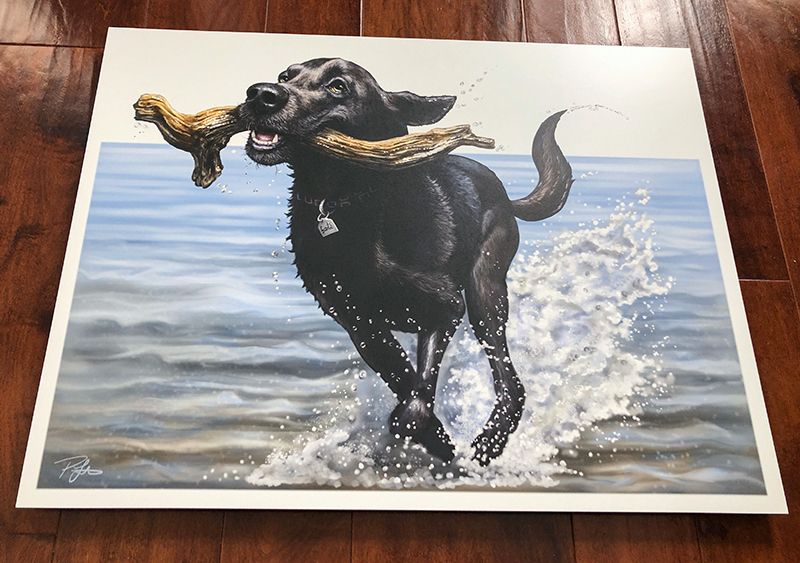 Last month, I finished what could easily be called my favourite
Last month, I finished what could easily be called my favourite 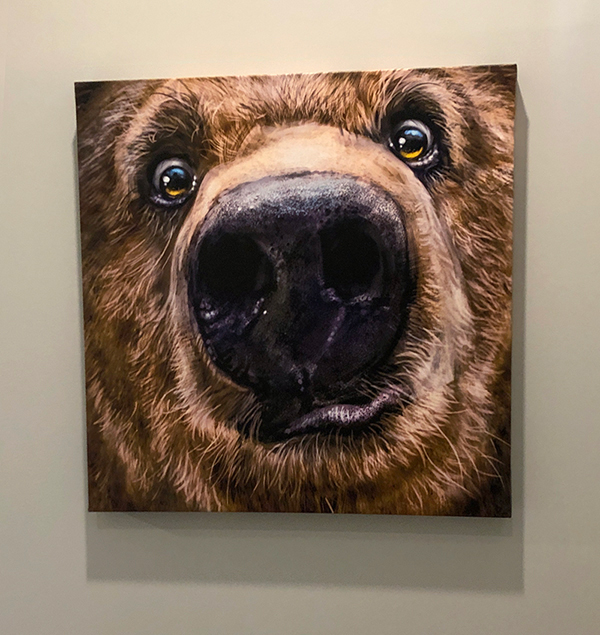 It’s always flattering to see my work in somebody’s home, especially a canvas of one of my personal favourites, my Berkley painting called “Peanuts.”
It’s always flattering to see my work in somebody’s home, especially a canvas of one of my personal favourites, my Berkley painting called “Peanuts.”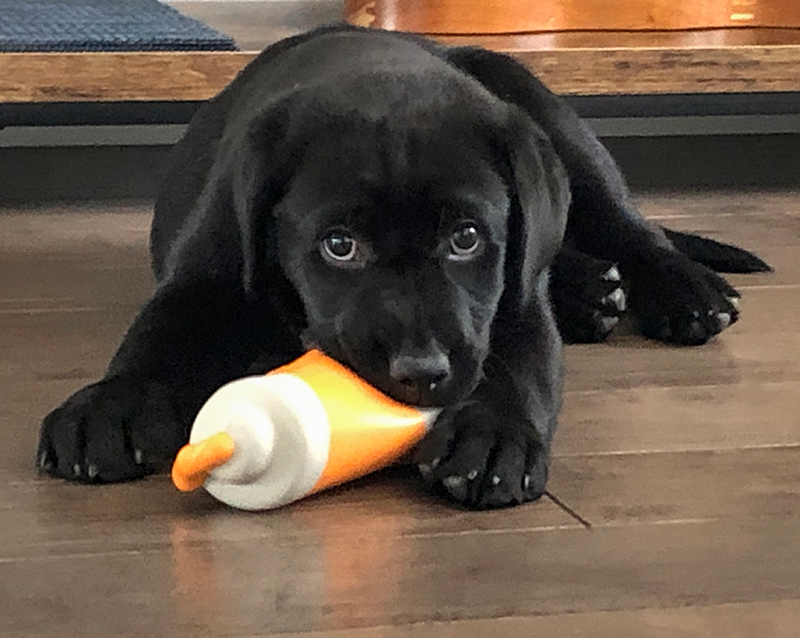 I got to meet Suzanne’s new little wonder, River, a black lab puppy, who is in that lovable, awkward, too small for her big paws stage.
I got to meet Suzanne’s new little wonder, River, a black lab puppy, who is in that lovable, awkward, too small for her big paws stage.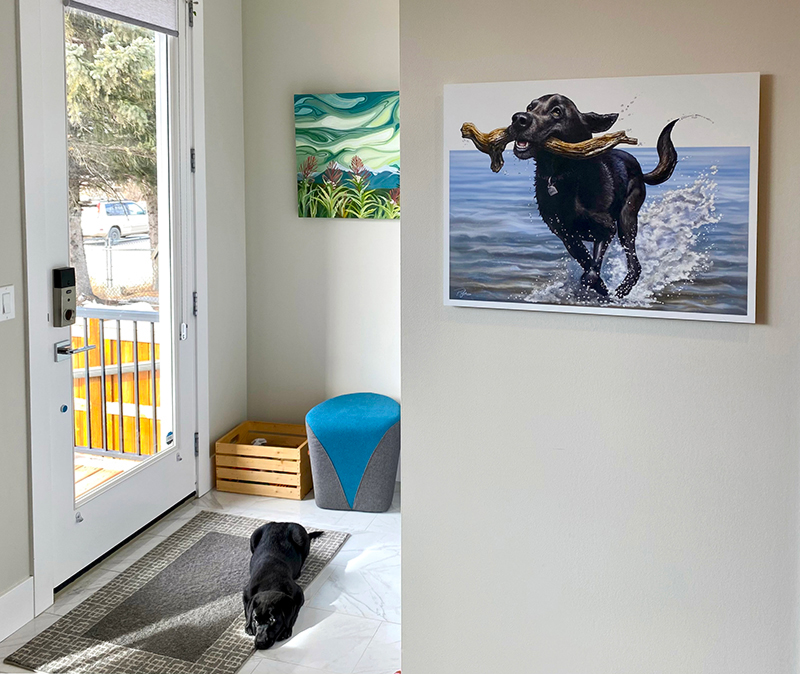 _____
_____
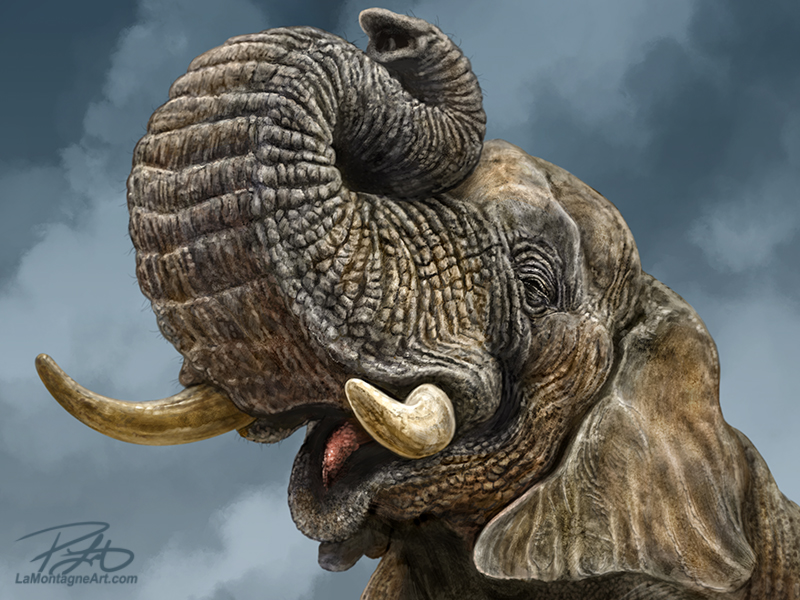 After more than two years of procrastinating, I finally finished this painting of an African elephant.
After more than two years of procrastinating, I finally finished this painting of an African elephant.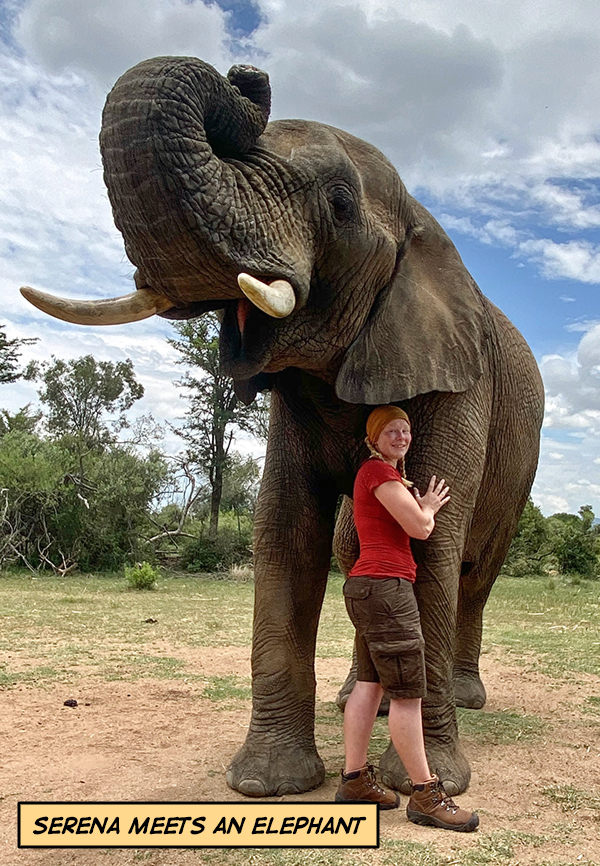
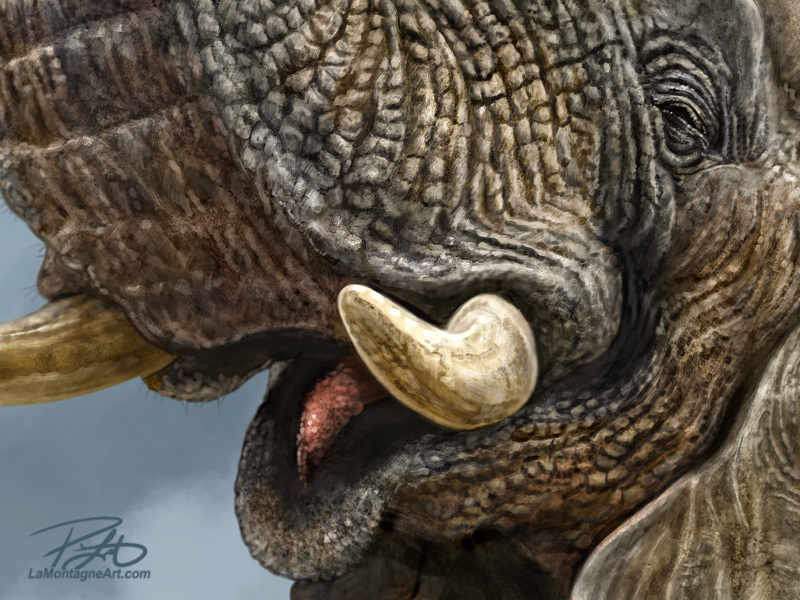 Secondly, the full-size four-day
Secondly, the full-size four-day 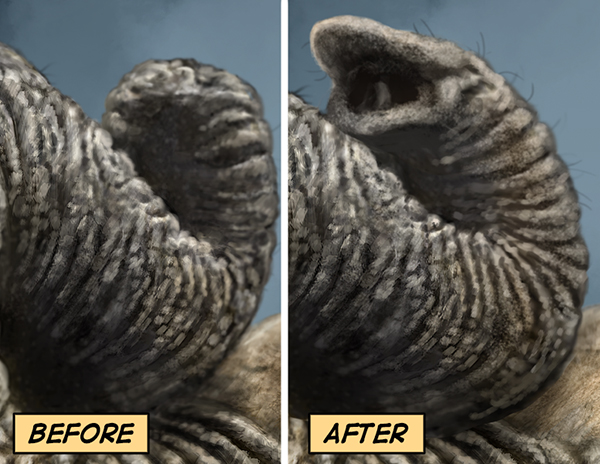 I sent a couple of changes to Serena, and she helped me get it right. She felt bad for having to tell me about it after I’d finished the painting, but I told her better than after I had bought dozens of prints, and coasters, trivets, magnets, and other licensed merchandise had gone into production.
I sent a couple of changes to Serena, and she helped me get it right. She felt bad for having to tell me about it after I’d finished the painting, but I told her better than after I had bought dozens of prints, and coasters, trivets, magnets, and other licensed merchandise had gone into production.
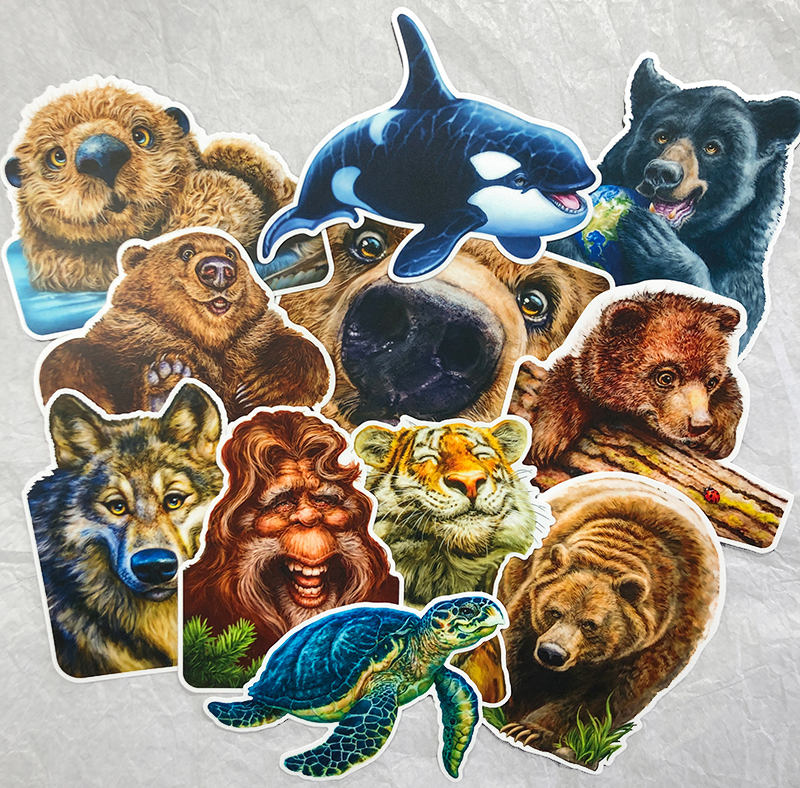
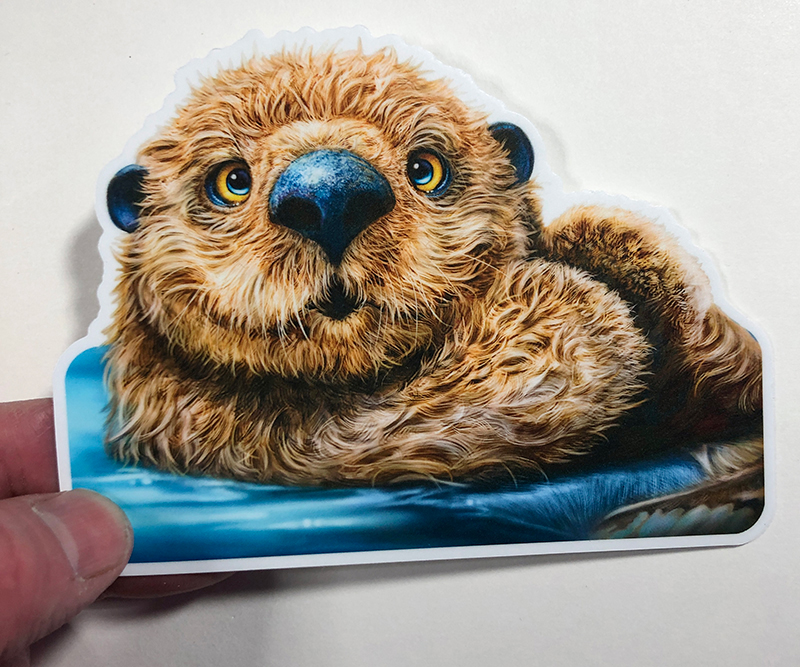 When I first moved to Canmore in 2001, I worked for a sign shop for a few years. Every place I’ve worked taught me skills I’ve applied to my own business. From that job, I learned design techniques, colour theory and how to create vector art. I still use vector paths and Bezier curves for clean ink lines in my editorial cartoons, a skill I learned at Canmore Sign Co.
When I first moved to Canmore in 2001, I worked for a sign shop for a few years. Every place I’ve worked taught me skills I’ve applied to my own business. From that job, I learned design techniques, colour theory and how to create vector art. I still use vector paths and Bezier curves for clean ink lines in my editorial cartoons, a skill I learned at Canmore Sign Co.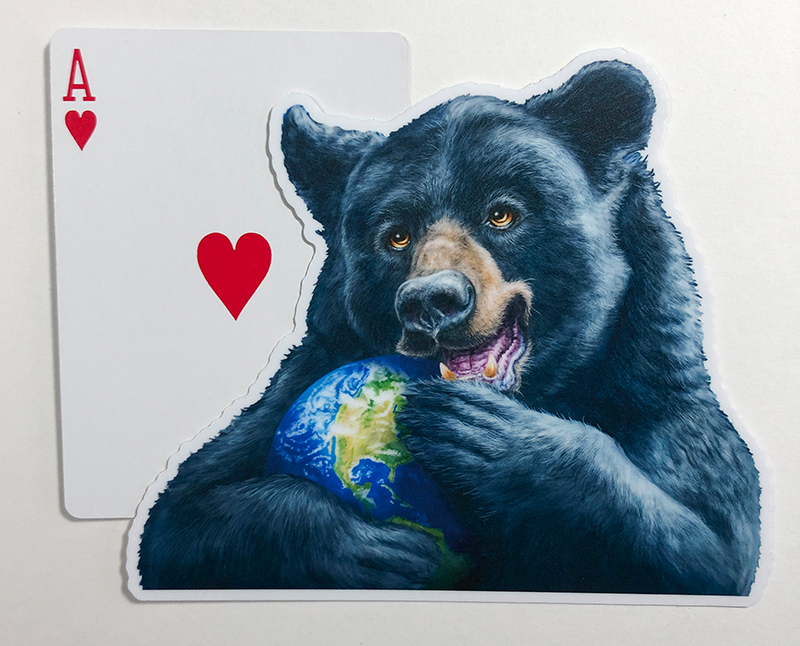 These are larger die-cut stickers than you will generally find, each around 4” X 5”. I didn’t want to shrink them down and lose the personality for which my whimsical critters are known. I also wanted people to have the option of putting them on vehicle windows, so they’re made from long-lasting, weather-resistant, high-quality vinyl. Finally, I chose a matte finish over glossy for better visibility in changing light.
These are larger die-cut stickers than you will generally find, each around 4” X 5”. I didn’t want to shrink them down and lose the personality for which my whimsical critters are known. I also wanted people to have the option of putting them on vehicle windows, so they’re made from long-lasting, weather-resistant, high-quality vinyl. Finally, I chose a matte finish over glossy for better visibility in changing light.
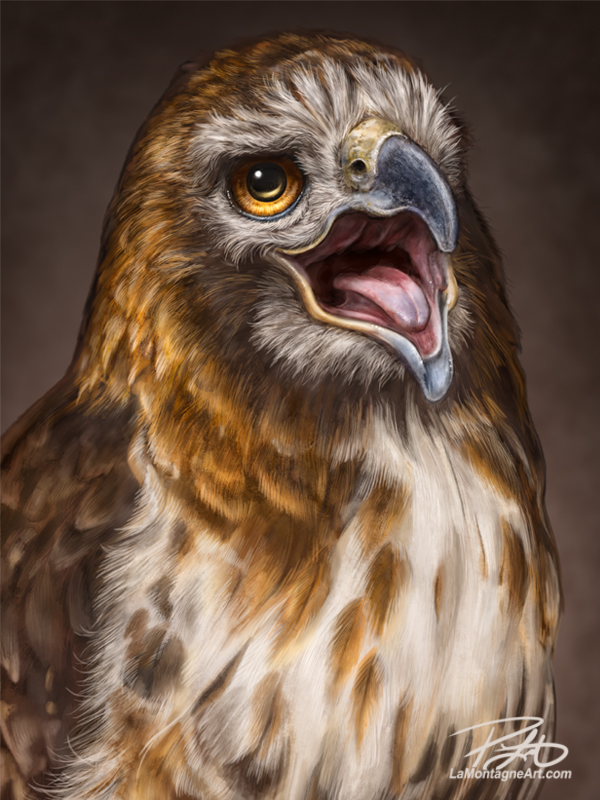 I’ve wanted to paint a Red-tailed Hawk for quite some time but could never seem to find the right reference. Though a common bird, my sightings in the wild have often been a comedy of bad timing.
I’ve wanted to paint a Red-tailed Hawk for quite some time but could never seem to find the right reference. Though a common bird, my sightings in the wild have often been a comedy of bad timing.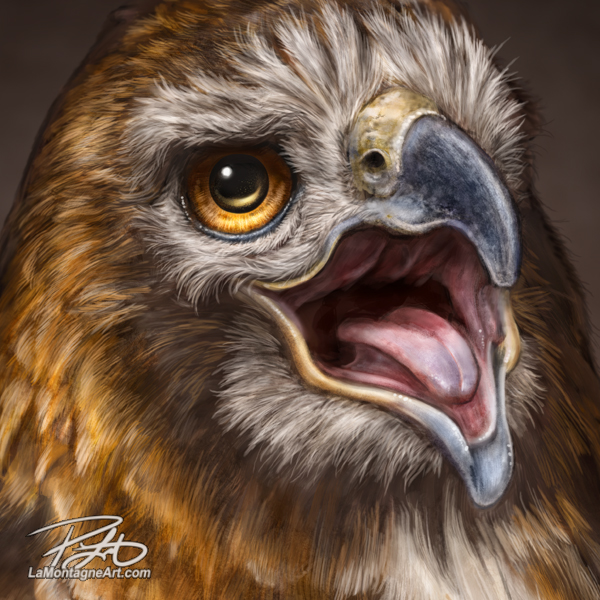

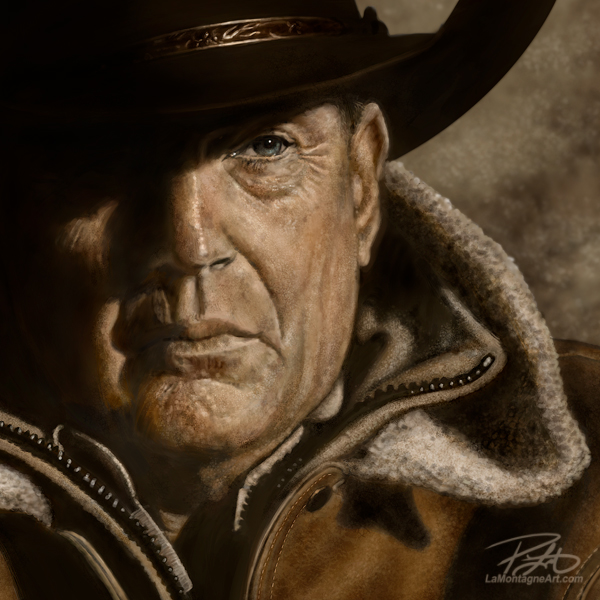
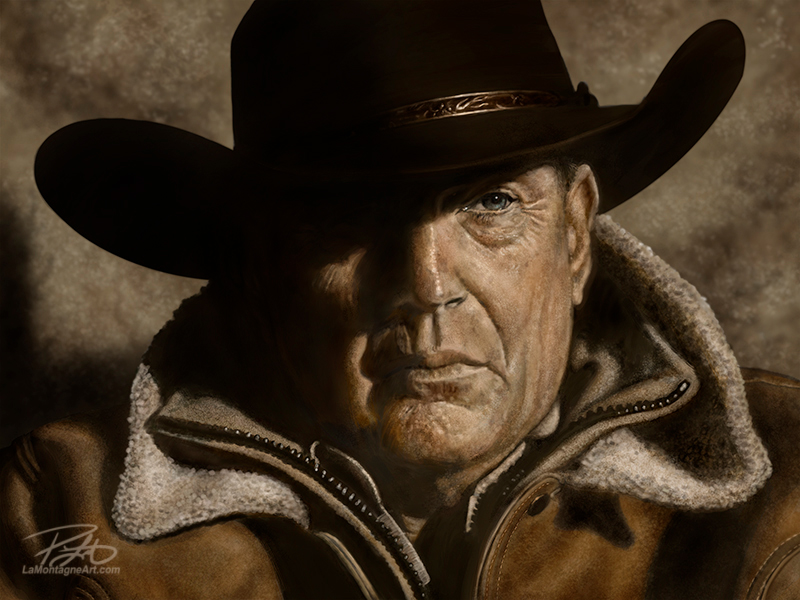 When I’m not drawing and distributing daily syndicated editorial cartoons, I’m painting whimsical wildlife portraits for prints and licensing. Add in the usual office administration, marketing, writing and everything else that goes along with self-employment, and that’s pretty much how I spend my days.
When I’m not drawing and distributing daily syndicated editorial cartoons, I’m painting whimsical wildlife portraits for prints and licensing. Add in the usual office administration, marketing, writing and everything else that goes along with self-employment, and that’s pretty much how I spend my days.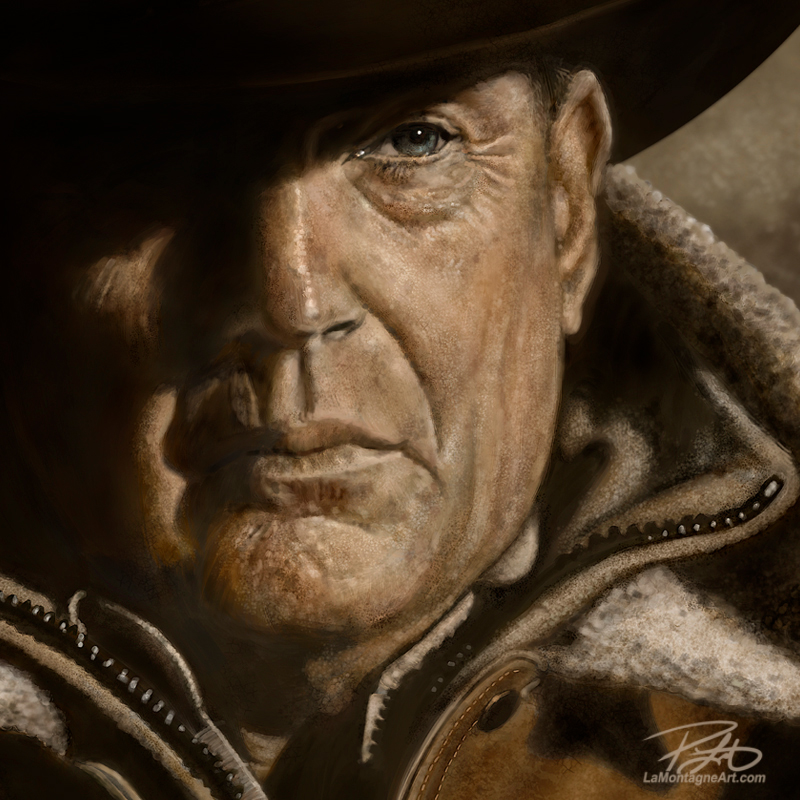 I started this painting in July, and I worked on it for a couple of hours here and there whenever I could find the time. I had planned to have it done before the fourth season began this month, but the paying gigs always take priority. So this past week, I put in the last ten or so hours over a few days. With no deadline, there was no reason to rush it, but I also didn’t want this painting to last for too much longer. As much as I loved the work, the best part is calling it done.
I started this painting in July, and I worked on it for a couple of hours here and there whenever I could find the time. I had planned to have it done before the fourth season began this month, but the paying gigs always take priority. So this past week, I put in the last ten or so hours over a few days. With no deadline, there was no reason to rush it, but I also didn’t want this painting to last for too much longer. As much as I loved the work, the best part is calling it done.